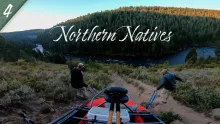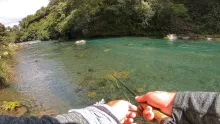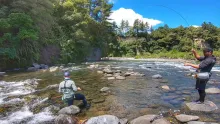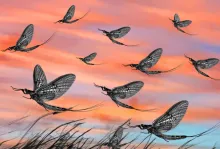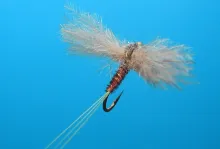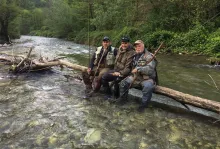Most of the rivers in Northern and mid Patagonia are lined with trees, most of which are willows, and in summer they supply one of the trout's favourite meals, the willow worm.
Last summer (December to March in the Southern hemisphere), my son Dickie and I fished one of the less known and fished rivers of northern Patagonia, the Aluminé, in the Province of Neuquén, Argentina; during our entire stay we only saw two other rafts.
The Aluminé
, which passes by the town of Aluminé, flows out of the Aluminé Lake up against the Andes close to Argentina's border with Chile. For the first few miles it is white water and great for rafting. Further downstream it slows down and all the way to the Collón Curá offers great dry fly and small nymphs fishing.
About 100 miles
south of the lake it flows into the Collón Curá River which downstream flows into the Limay River which after becoming the Rio Negro, flows into the Atlantic Ocean.
We fished
for four days floating downstream in catarafts belonging to our outfitter, Diego Buzzurro. Daily we would cover about 10 miles of river, having an excellent picnic lunch by the river. We left our lodging at about 8 am, be fishing half an hour later and finish up at around 8 pm. We fished different stretches of the Aluminé every day.
Our host
and his guide Santiago were very professional, knowledgeable and good company; rowing the rafts into the right casting position and with honed eyesight would point out the cruising trout and rises. They would constantly check our leaders and tippets (5x) and replace them or our flies with nimble fingers. Dickie used his #3 rod and I used a #4 with floating lines. At times it was windy, but in general lighter gear could be used.
Most of the rivers
in Northern and mid Patagonia are lined with trees, most of which are willows, and in summer they supply one of the trout's favourite meals, the willow worm. These worms (Nematus Desantisi), which later turn into a moth like butterfly, are a bright lemon green (also known as "chartreuse"), the colour of the leaves they consume in vast quantities, are about 2 cm or ¾ of an inch long. The bright sun or winds daze them and they fall off the leaves they are eating into the river where they are promptly eaten by the waiting trout that lie close to the banks in the shade offered by the willows awaiting the morsel.
Placing the fly
correctly is a challenging cast as the openings in the branches are small and many times the cast has to be made parallel to the water. A plentiful supply of flies is necessary as the risk of losing them in the branches is high, especially if you do not want to spook the fish by rowing up to the branches to release the hook.
My best catch
, a 5 pound rainbow, was the result of a great cast right up against the bank through a small opening in the branches of the willows and I saw the gaping mouth of the trout as it daintily took the worm fly right after it touched the water.
I had several flies
tied with bright green chenille but these absorbed water very quickly and sank. Though caught one or two fish whilst retrieving, they did not do the job well. Unfortunately our outfitter had run out of flies tied with foam (it was mid February and late in the season and the loss of flies in the branches is considerable), but had a piece of lemon green foam which he cut into two millimeter strips about 2 centimeters long and put them onto a # 14 shrimp hook such as the TMC 2457, as if baiting the hook.
These flies
were very successful. Dickie's best catch was a 23 inch rainbow, also taken with these worms.
We also fished with attractor dries, small midges, caddis, spinners and emergers.
We had three
bright sunlit days and one day it was overcast, and though it was quiet at times, we caught at least ten fish a day each.
We had contracted daily trips so every evening we returned to our very comfortable lodging in the "Casa de Campo", where the owners, Marisa Castro and Daniel Creado treated us with great evening meals.
Diego also offers a camping trip, three days and two nights, where a great length of the Aluminé, inaccessible by land, can be fished. For those familiar with the area this is from Pilolil to where the Aluminé flows into the Collón Curá. Hopefully next year we will do this.
On my return home
I got some green foam, not chartreuse, and tied some of these inch worms, first tying extended bodies which I then attached to the hook. (see attached photograph and Davie McPhail's system for tying extended bodies)
Facts
- Diego can be contacted through his web site at www.achalaexperience.com.ar
- Casa de Campo Bed & Breakfast can be found at www.casadecampoalumine.com.ar
- The author Pedro (Peter) Alfredo Miles can be contacted through mail pedroalfredomiles@gmail.com
- Log in to post comments









